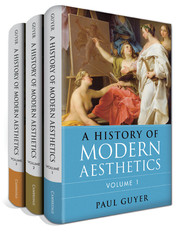Book contents
- Volume 1 The Eighteenth Century
- Volume 2 The Nineteenth Century
- Frontmatter
- Contents
- Acknowledgments
- Introduction
- Part One German Aesthetics in the First Half of the Nineteenth Century
- Part Two (Mostly) British Aesthetics in the Second Half of the Nineteenth Century
- 5 Ruskin
- 6 Aestheticism
- 7 Bosanquet and Tolstoy
- Part Three German Aesthetics in the Second Half of the Nineteenth Century
- Bibliography
- Index
- Volume 3 The Twentieth Century
- References
6 - Aestheticism
The Aestheticist Movement
from Part Two - (Mostly) British Aesthetics in the Second Half of the Nineteenth Century
Published online by Cambridge University Press: 05 June 2015
- Volume 1 The Eighteenth Century
- Volume 2 The Nineteenth Century
- Frontmatter
- Contents
- Acknowledgments
- Introduction
- Part One German Aesthetics in the First Half of the Nineteenth Century
- Part Two (Mostly) British Aesthetics in the Second Half of the Nineteenth Century
- 5 Ruskin
- 6 Aestheticism
- 7 Bosanquet and Tolstoy
- Part Three German Aesthetics in the Second Half of the Nineteenth Century
- Bibliography
- Index
- Volume 3 The Twentieth Century
- References
Summary
One of the characteristic cultural movements of the nineteenth century was “aestheticism,” the movement captured by the slogans “l’art pour l’art” or “art for art’s sake.” In large part, this was a movement of artists and writers rather than of professional philosophers, yet it responded to the moralism not only of John Ruskin, but also of some more academic aesthetics early in the century, and it prepared the way for some of the more academic aesthetics of the end of the century and the beginning of the next, especially in Britain. So it cannot be overlooked here.
In its earlier phase, the aestheticist movement did not offer a positive theory of what aesthetic experience or art is, but rather protested against other, especially moralistic accounts of what the function of art is – the slogan “art for art’s sake” does not explain what art is, but only implies that it is not for the sake of something else, for example, morality, religion, the state, or metaphysics. In other words, the slogan “art for art’s sake” was the banner of a protest movement, not the name of a philosophical theory. But as we previously saw, an academic aesthetician in mid-century such as Friedrich Theodor Vischer also emphasized that beauty was not for the sake of religion, state, or society, without denying the possibility of a theory of beauty, so an insistence upon the autonomy of aesthetic experience and art from societal constraints does not necessarily lead to a rejection of serious aesthetic theory. And, later in the aestheticist movement, obviously in the works of the Oxford classicist and critic Walter Pater, the theory of beauty that was offered was broader rather than narrower, and suggested the possibility for a comprehensive rather than reductive approach to aesthetic theories.
- Type
- Chapter
- Information
- A History of Modern Aesthetics , pp. 229 - 269Publisher: Cambridge University PressPrint publication year: 2014



